DETAILS
IN
CONVENT OF CHRIST
 Português Português
A ordem dos Templários foi extinta em quase toda a Europa de 1312 a 1314, mas em Portugal os seus membros, bens e alguns hábitos foram transmitidas foram transferidas para a ordem de Cristo, fundada em 1319 pelo Rei D. Dinis. A ordem de Cristo mudou-se para Thomar em 1357, que acabaria por se tornar o seu quartel general.
Um dos mais importantes Grão Mestres da Ordem foi o Infante D. Henrique, o Navegador, que liderou a ordem de 1417 até à sua morte em 1460. D. Henrique deu um grande impulso aos exploradores Portugueses durante a época dos descobrimentos. No Convento o Infante ordenou a construção de vários claustros entre outros edifícios. Ele também patrocinou o desenvolvimento urbano da cidade de Thomar.
Outra importante personalidade ligada à Ordem de Cristo foi o rei D. Manuel I, que se tornaria Mestre da Ordem em 1484 e rei de Portugal em 1492. Durante o seu reinado existiram vários melhoramentos importantes no Convento, especialmente a adição da nave manuelina à charola e as suas decorações internas com pinturas e esculturas.
O sucessor de D. Manuel I, o rei D. João III, desmilitarizou a ordem, tornando-a numa ordem virada mais para a religião com uma regra baseada na de Bernard de Clairvaux. Ele também mandou erguer um novo claustro em 1557, que é um dos melhores exemplos da arquitectura renascentista em Portugal.
Em 1581, depois de uma crise de sucessão, a nobreza Portuguesa juntou-se na casa do capitulo no Convento de Cristo em Thomar, e reconheceu oficialmente Filipe II de Espanha (Filipe I de Portugal) como rei, assim se iniciou a união ibérica (1581-1640), durante a qual as coroas de Portugal e Espanha ficam unidas por uma união dinástica. O aqueduto dos Pegões foi construído durante este período.
 English English
The Templar order was suppressed through most of Europe from 1312 to 1314, but in Portugal it\\\'s members, assets, and partly it\\\'s habits, were transmitted to the Order of Christ, created in 1319 by king Dinis. The order of Christ moved to Tomar in 1357, which became it\\\'s headquarters.
One of the most important Grand Masters of the order was Prince Henry the Navigator, who ruled the order from 1417 up to his death in 1460. Prince Henry gave great impulse to the pioneering Portuguese expeditions during the age of explorations. In the Convent, Prince Henry ordered the construction of various cloisters and other building. He also sponsored urban improvements in the town of Tomar.
Another important personality related to the order was king Manuel I, who became Master of the order in 1484 and king of Portugal in 1492. Under his reign there were several important improvements in the Convent, specially the addition of a new nave to the round church and it\\\'s inner decoration with painting and sculptures.
The successor of D. Manuel I, king Joao III, demilitarised the order, turning it into a more religious order with a rule based on that of Bernard of Claivaux. He also ordered the construction of a new cloister in 1557, which is one of the best examples of renaissance architecture in Portugal.
In 1581, after a succession crisis, the Portuguese nobility gathered in the Convent of Christ in Tomar and officially recognised Philip II of Spain (Philip I of Portugal) as king. This is the beginning of the Iberian union (1581-1640), during which the crowns of Portugal and Spain were united in a Dynastic union. The aqueduct of the convent was built during this period.
THE CACHE
 Português Português
Para resolver esta letterbox hibrid os geocachers têm de fazer um circuito no interior do Convento de Cristo com uma visão mais detalhada sobre o local. O circuito inicia-se na porta Manuelina junto à receção, e termina no claustro da micha junto à porta de saída do monumento.
Em cada ponto, terão de encontrar o detalhe entre as 3 opções que se encontram no local.
Todos os detalhes nas fotos existem no Convento de Cristo, por isso mantenham os olhos bem abertos e irão ver coisas que nunca se aperceberam neste maravilho monumento.
Ponto 1 - Porta Manuelina exterior da charola A
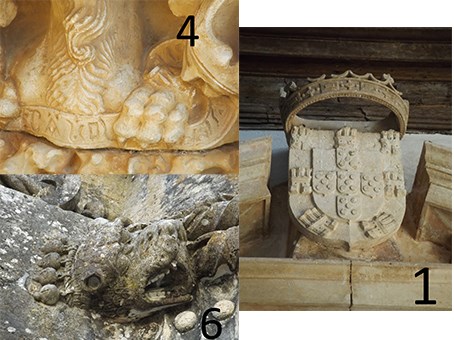
- Após descobrir este detalhe único em todo o Convento, sigam para a entrada do monumento.
Ponto 2 - Ao passar a portaria, virem à direita até chegar ao Claustro da Lavagem, aí irão encontrar o segundo detalhe, olhem para todos os lados, cima e baixo também contam! B
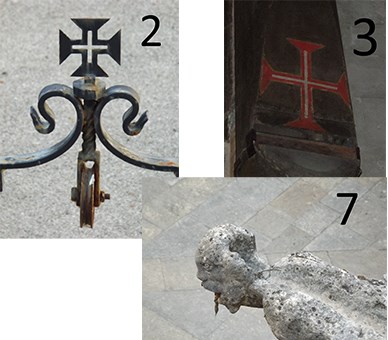
- Sigam na direção contrária de onde vieram e dirijam-se à charola do Convento, o local mais emblemático de todo o edificio.
Ponto 3 - Aproxima-te da entrada da rotunda Templária, procura no arco frontal com S. António o terceiro detalhe, este é pequeno e dificil C
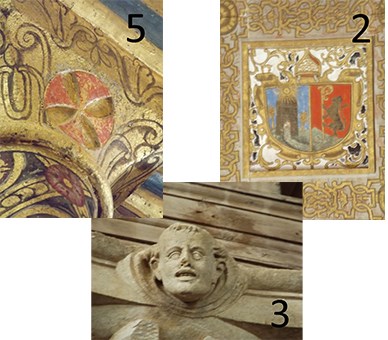
- Sigam pela porta de vidro na direção do claustro principal.
Ponto 4 - Nestre claustro, reconstruido por D. João III irão encontrar este detalhe, atenção que existem 3 níveis, o detalhe está no centro do claustro, mas apenas é visivel de 1 dos níveis. D
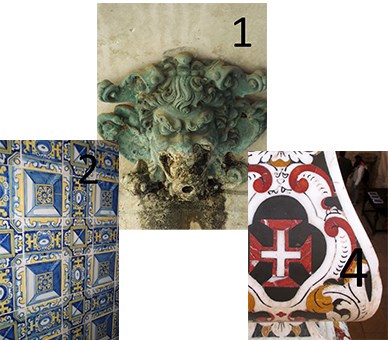
Ponto 5 - Sigam até ao canto oposto do claustro que tem um formato de um quadrado, e irão encontrar uma porta que vos leva ao corredor do Cruzeiro, local onde viviam os monges do séc. XVI em diante. Este detalhe encontra-se algures no interior deste corredor, não está em nenhuma das celas. E
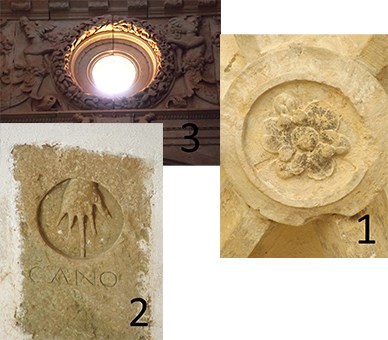
- Após darem com este detalhe sigam até à porta aberta que leva a uma varanda, nessa varanda descam a escada em caracol (cuidado para não cair!).
Ponto 6 - Após descer a escada irão ver do vosso lado direito a janela do capitulo, símbolo máximo do estilo Manuelino, coloquem-se o mais perto possível e deliciem-se com todos os detalhes que tornam esta uma peça de arte única no mundo. Aproveitem também para encontrar o sexto detalhe F
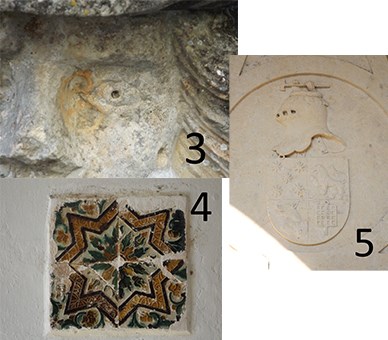
- Junto à janela, descam as escadas e virem à esquerda e imediatamente à direita irão encontrar uma porta que leva ao refeitório(se não encontraram o detalhe D, agora é uma boa altura mais de perto).
- No refeitório entrem à direita, e quando chegarem às escuras cozinhas, descam as escadas e virem à direita, encontrando ao fundo o segundo maior claustro do convento, o claustro da Micha.
Ponto 7 - Ao fundo do claustro encontram-se umas escadas para a siterna que se encontra debaixo dos vossos pés, à vossa volta vêm-se vários detalhes, procurem no teto e irão encontrar o último detalhe G
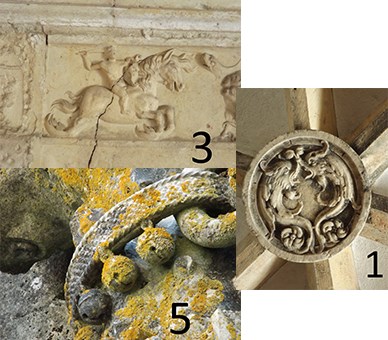
Para encontrarem o ponto final juntem todos os detalhes e solucionem esta equação que vos leva ao ponto final:
N 39º 3(A+B).(G)(A+C)(F+A)
W 008º 2(F+B).(D+G)(A)(E+G)
 English English
To solve this letterbox hibrid the geocachers need to do a circuit in the interior of the Convent of Christ with a more details look over the place. The circuit starts in the Manueline door next to the reception, and ends in the cloyester of the "Micha" next to the exit door of the monument.
In each point, you need to find the correct details between the 3 options that we give you in the correct place.
All the details in the pictures exist in the Convent of Christo, so keep your eyes wide open and you will see things that you never imagined in this wonderful monument.
Point 1 - The Manueline door in the outside of the Templar building, you can find it in the corner of the big plaza next to the monument reception A

- After find this unique detail in all Convent, follow into the reception of the monument.
Point 2 - Passing the reception, turn right until you reach the washing cloyester, there you will find the second detail, look everywhere, up and down are important too! B

- Follow in the oposite direction where you came from and move to the entrance of the Convent rotund, the most emblematic place of all complex.
Point 3 - Get near the entrance of the Templar rotund, search in the front arch with S. Antony (monk) and look for the third detail, this one is small and a bit hard, look carefully C

- Follow to the glass door in the direction of the main cloyester.
Point 4 - In this cloyester, rebuild by D. João III you will find this detail, carefull, there are 3 levels in this area, the detail is only visible from one of them D

Point 5 - Follow to the oposite corner of the cloyster that have a shape of a square, you will find a door that will take you to the "Cruzeiro" corridor, place where the monks of the XVI century. This detail is somewhere in the corridor, you don\'t need to search in any of the rooms E

- After you get this detail, follow into the open door that will take you to a balcony, in that balcony go down the stairs (careful to don\'t fall!).
Point 6 - After going down the stairs you will see at your right the chapter window, the ultima symbol of the Manuelin style, get as near as possible and get delighted with all the details that turns this piece of arquitecture unique in the world. Get this chance to find the sixth detail F

- Next to the window, go down the stairs and turn left and imediatly right you will find a door that will take you the dinner room (if you didn\'t found the detail D, now is a good moment to search a bit better).
- In the dinner room turn right, and when you get into the dark kitchen, go down the stairs and turn right, at the end you will find the second biggest cloyester of the convent, the cloyster of "Micha"
Point 7 - At the end of the cloyster you will find stairs that will take you the systern that exist under your feel, search in the ceilings around you to find the last detail G

To find the final point get together all the details and complete this simple equation that will take you to the final container:
N 39º 3(A+B).(G)(A+C)(F+A)
W 008º 2(F+B).(D+G)(A)(E+G)
Esta cache foi baseada na cache DP9 - DETAILS do danieloliveira, e sugerida pelo paulohercules. Aos dois um grande agradecimento pelas informações e ideias que usei neste listing.
|